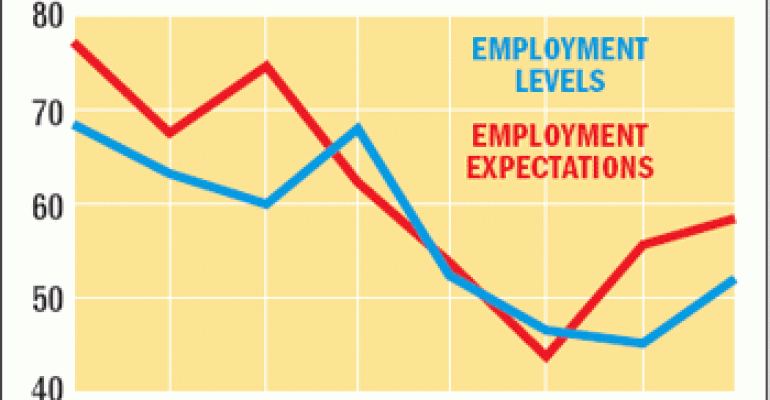DALLAS Chain operators say they expect to hire more people heading into the third quarter, a sign that could indicate the markings of a turnaround, according to the latest Workforce Index by People Report, a firm that tracks human resources trends for more than 100 restaurant companies.
The Workforce Index released July 22 noted that by the end of the second quarter of this year, the employment level was the highest it had been in the past 12 months, foreshadowing employment growth in the industry.
Among the 70 companies surveyed for the Workforce Index, 38 percent reported adding hourly workers, up from 14 percent in the index’s second quarter analysis, and only 15 percent reported payroll deductions. Likewise, 31 percent added management positions, and another 42 percent were maintaining current staffing levels.
In addition, 19 percent planned to add hourly workers in the third quarter, while 12 percent planned to reduce staff. Also, 24 percent said they planned to add management hires, while just 4 percent were preparing for layoffs.
Better times may be ahead, despite the nation’s high unemployment rate, said Joni Doolin, founder and chief executive of People Report.
“What’s going on with unemployment is not pretty and clearly it’s impacting all industry trends and employment, however, it is a lagging economic indicator,” Doolin said.
National unemployment was 9.5 percent in June, 4 percent higher than in June 2008. Fifteen states had double-digit unemployment rates in June, according to the U.S. Bureau of Labor statistics, including Illinois and Florida at 10 percent, Ohio at 11.1 percent, California at 11.6 percent, Oregon at12.2 percent and Michigan at 15.5 percent.
The industry has seen an increase in the number of jobs since the economy crashed in September, however. After losing almost 22,000 jobs in the first three months of this year, the industry added 21,000 in the second quarter, according to the Workforce Index.
“We’ve just about replaced what was lost in Q1,” said Michael Harms, a senior analyst for People Report. “There was a huge loss the last three months of last year, and job growth was minimal. Then in April we were provided with some hope that maybe they have turned the corner.”
While the majority of companies maintained their staffing levels, 30 percent reported adding hourly employees in the second quarter, up from 23 percent for the first quarter of 2009.
The Workforce Index measures operators’ personnel expectations in five areas: employment levels, recruiting difficulty, job vacancies, turnover and employment expectations, or the expected increase or decrease in head count for hourly and manager positions. A reading of 50 or more indicates strong growth or pressure to fill vacancies, recruit and increase staff, less than 50 means a decrease in growth and pressures.
The combined measure of all five components was 47.3, showing increased employment pressures for operators. That compared to 43.8 in the second quarter. The employment expectation was 58.3, up from 55.4 from the start of the second quarter, indicating operators would be increasing their payrolls in the months ahead.
The Workforce Index also analyzed data on the five components for four industry segments, including casual dining, quick service, fast casual/family dining and fine-dining or high-volume restaurants.
Casual dining posted the highest employment levels at the start of the third quarter, after experiencing declining payrolls in the previous three quarters, Harms said.
“Casual dining was struggling long before anyone else,” he said. “They’ve ceased cutting jobs and have added some jobs. It was refreshing to see that.”
Some casual-dining operators are planning to add units this year and next year despite the nation’s high unemployment rates, Doolin said. But they are mostly avoiding states with double-digit unemployment rates, including California, Florida and Michigan.
Turnover and recruiting difficulty have remained relatively flat, mostly due to the nation’s continued high unemployment rate, according to the index.
Contact Dina Berta at [email protected].

